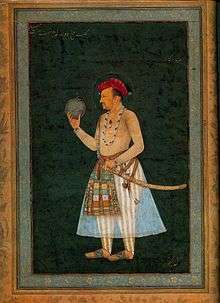Tuzk-e-Jahangiri
Tuzuk-e-Jahangiri or Tuzuk-i-Jahangiri (Persian: تزک جهانگیری ) is the autobiography of Mughal Emperor Nur-ud-din Muhammad Jahangir (1569-1627). Also referred to as Jahangirnama,[1] Tuzk-e-Jahangiri is written in Persian, and follows the tradition of his great-grandfather, Babur (1487-1530), who had written the Baburnama; though Jahangir went a step further and besides the history of his reign, he includes details like his reflections on art, politics, and also information about his family.
Overview

The text details the first nineteen years of his reign, but gave up the writing of his Memoirs in the seventeenth year of his reign. He then entrusted the task to Mu‘tamad Khān, the author of the Iqbal-nama, who continued the Memoirs to the beginning of the nineteenth year. From where, it was taken up by Muhammad Hadi, who continued it to Jahangir's death. It forms an important reference point for the era along with his father, Akbar's, Akbarnama. The first important printed version of Jahangirnama was by Sayyid Ahmad, printed at Ghazipur in 1863 and at Aligarh in 1864.[2]
Jahangir's autobiography also reflects the royal ideology of Jahangir’s views on various political, religious and social issues. Within the memoir, he noted many of his local level legislative policies in his large empire consisting of most of modern day India, Pakistan, and Bangladesh. Among them were his decrees to manage and regulate the jagirdars. Jagirdars were holders of the jagir, the emperor’s land grant title. The jagirdars were to take the income of the land and use it mainly to finance the maintenance of the troops and to address the town needs. Jahangir made various attempts to halt corruption within the jagirdars. He prohibited each of them from using the money for personal profit by ordering that part of the land income to go to hospitals and infirmaries and for each town to be equipped with religious buildings according to the religion of that area. Jahangir also kept the jagirdars from gaining interest in family or land riches by ordering for jagirdars to seek his approval before marrying someone from the town they ruled in.
Bibliography
- Henry Miers Elliot (1875). Wakiʼat-i Jahangiri. Lahore: Sheikh Mubarak Ali.
- Jahangir, Emperor of Hindustan (1829). Memoirs of the Emperor Jahanguir. Translated by Price, Major David. London: J. Murray.
- Jahangir, Emperor of Hindustan (1909). Beveridge, Henry, ed. The Tuzuk-i-Janhangīrī or Memoirs of Jahāngīr. Translated by Rogers, Alexander. London: Royal Asiatic Society.
- Jahangir, Emperor of Hindustan (1999). The Jahangirnama: Memoirs of Jahangir, Emperor of India. Translated by Thackston, Wheeler M. Oxford University Press. ISBN 978-0-19-512718-8.
See also
References
| Wikimedia Commons has media related to Jahangirnama. |
- ↑ Jahangiri Intro.
- ↑ Preface The Tūzuk-i-Jahangīrī by Alexander Rogers and Henry Beveridge, Royal Asiatic Society, 1909–1914.
